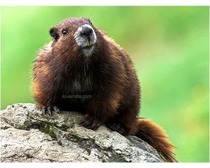Vancouver Island Marmot is found in the hilly areas of Vancouver Island, in British Columbia, Canada. Read on to know certain interesting facts and amazing information on Vancouver Island Marmots.
Facts About Vancouver Island Marmot
The Vancouver Island marmot is a unique species of mammals, found wild in the hilly areas of Vancouver Island in British Columbia, Canada. They are categorized scientifically under the biological name (Marmota vancouverensis) and are regarded as the largest members of the squirrel family. Although mostly prevalent in the hilly areas of the Island, today, a few members can be found in captive breeding centers across Canada as well. A number of recovery programs are being designed and carried out in different parts of Canada to prevent the extinction of this exquisite species and restore its number. Vancouver Island marmot has a strong stocky body, with a chubby face and small ears. The shade of the lustrous fur is usually a rich chestnut brown, with a creamy patch around their nose and mouth, extending till the underside of their neck. Its pups are very small and have dark brown to black fur over their body. To know some more interesting facts and amazing information on the species, check the information given below.

Vancouver Island Marmot Facts
Kingdom: Animalia
Phylum: Chordata
Subphylum: Vertebrata
Class: Mammalia
Order: Rodentia
Family: Sciuridae
Genus: Marmota
Species: M. vancouverensis
Size: Approx 65 to 70 cm from the tip of the nose to the tip of the tail
Weight: Adult males: 7 kg, adult females: 3 kg (approx)
Life Span: Males: 5 to 6 years, females: 7 to 9 years
Diet: 50 species of grass and flowering plants
Range: south-central Vancouver Island (Canada), Mount Washington
Habitat: south or west facing alpine meadows at high altitudes (over 1000 m), clear cut areas
Age of Sexual Maturity: 4 years of age
Gestation Period: 30 to 35 days
Number of Offspring: 3 pups
Interesting & Amazing Information On Vancouver Island Marmots
- Vancouver Island marmot is one of the most endangered species found in the hills of the Vancouver Island, in Canada.
- At present, there are only about 100 marmots surviving in the world.
- These mammals are also known as "whistle pigs", as they make a peculiar whistle-like sound when they are facing any kind of danger.
- They are purely vegetarians and survive on grass, herbs and flowering plants. They are particularly very fond of peanut butter.
- On an average, Vancouver Island marmot hibernates for around 210 days of the year, starting from late September or early October. During this stage, its heart beats around 3 or 4 times per minute. On the other hand, in the active season, the heart beat ranges from 110 to more than 200 beats per minute.
- The animal has strong arms, shoulders and legs. Its long claws help it to climb and move around steep, rocky regions and also help it dig burrows.
- Rocks are essential for these unique mammals, as they help them to cool down when cold. They also help them warm up, if they have been baking in the sun. Besides, these rocks also help them watch out for predators, by providing them an elevated spot.
- Vancouver Island marmots live in underground burrows and use dry mosses and grasses as bedding.
- As these animals are on the verge of getting extinct, scientists and wildlife activists are struggling to preserve this species and maintain a healthy population of about 400 to 600 Vancouver Island marmots in the wild.
- The main predators of the Vancouver Island marmots are golden eagles, cougars and wolves.


See also
More from iloveindia.com
- Home Remedies | Ayurveda | Vastu | Yoga | Feng Shui | Tattoos | Fitness | Garden | Nutrition | Parenting | Bikes | Cars | Baby Care | Indian Weddings | Festivals | Party ideas | Horoscope 2015 | Pets | Finance | Figures of Speech | Hotels in India : Delhi | Hyderabad | Chennai | Mumbai | Kolkata | Bangalore | Ahmedabad | Jaipur
- Contact Us Careers Disclaimer Privacy Policy Advertise With Us Lifestyle Sitemap Copyright iloveindia.com. All Rights Reserved.




